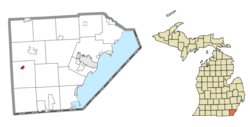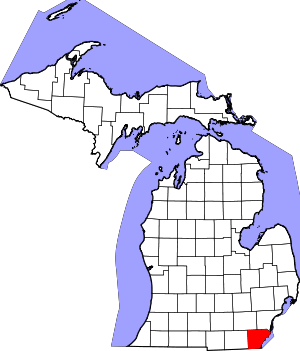Petersburg, Michigan
Petersburg is a city in Monroe County in the U.S. state of Michigan. The population was 1,146 at the 2010 census.
Petersburg, Michigan | |
|---|---|
| City of Petersburg | |
Looking west along East Center Street | |
 Location within Monroe County | |
 Petersburg Location within the state of Michigan | |
| Coordinates: 41°54′04″N 83°42′54″W | |
| Country | United States |
| State | Michigan |
| County | Monroe |
| Founded | 1836 |
| Government | |
| • Type | Mayor–council |
| • Mayor | James Holeman |
| • Clerk | Leanne Goodin |
| Area | |
| • Total | 0.49 sq mi (1.27 km2) |
| • Land | 0.48 sq mi (1.25 km2) |
| • Water | 0.01 sq mi (0.02 km2) |
| Elevation | 676 ft (206 m) |
| Population | |
| • Total | 1,146 |
| • Estimate (2019)[3] | 1,128 |
| • Density | 2,335.40/sq mi (902.09/km2) |
| Time zone | UTC-5 (Eastern (EST)) |
| • Summer (DST) | UTC-4 (EDT) |
| ZIP code(s) | 49270 |
| Area code(s) | 734 |
| FIPS code | 26-63800[4] |
| GNIS feature ID | 0634708[5] |
| Website | Official website |
With a total area of 0.48 square miles (1.24 km2), Petersburg is ranked as the smallest city by total area in the state of Michigan. However, the city of Clarkston has a larger total area (when water is included) but a smaller land area at only 0.44 square miles (1.14 km2), which ranks Petersburg as the second-smallest city in land area.
History
Petersburg is named after Richard Peters, who sold the land necessary to found the town in 1836. It was originally called Summerfield and Peters was its first postmaster, but it was later named Petersburgh in honor of Peters and was eventually shortened to Petersburg.[6]
Geography
According to the United States Census Bureau, the city has a total area of 0.48 square miles (1.24 km2), all land.[7]
Demographics
| Historical population | |||
|---|---|---|---|
| Census | Pop. | %± | |
| 1880 | 420 | — | |
| 1890 | 408 | −2.9% | |
| 1900 | 468 | 14.7% | |
| 1910 | 490 | 4.7% | |
| 1920 | 514 | 4.9% | |
| 1930 | 705 | 37.2% | |
| 1940 | 789 | 11.9% | |
| 1950 | 1,001 | 26.9% | |
| 1960 | 1,018 | 1.7% | |
| 1970 | 1,227 | 20.5% | |
| 1980 | 1,222 | −0.4% | |
| 1990 | 1,201 | −1.7% | |
| 2000 | 1,157 | −3.7% | |
| 2010 | 1,146 | −1.0% | |
| Est. 2019 | 1,128 | [3] | −1.6% |
| U.S. Decennial Census[8] | |||
2010 census
As of the census[2] of 2010, there were 1,146 people, 449 households, and 315 families living in the city. The population density was 2,387.5 inhabitants per square mile (921.8/km2). There were 476 housing units at an average density of 991.7 per square mile (382.9/km2). The racial makeup of the city was 97.1% White, 0.3% African American, 0.3% Native American, 0.3% Asian, 0.3% from other races, and 1.6% from two or more races. Hispanic or Latino of any race were 1.7% of the population.
There were 449 households, of which 35.4% had children under the age of 18 living with them, 50.6% were married couples living together, 14.7% had a female householder with no husband present, 4.9% had a male householder with no wife present, and 29.8% were non-families. 22.5% of all households were made up of individuals, and 9.2% had someone living alone who was 65 years of age or older. The average household size was 2.55 and the average family size was 3.00.
The median age in the city was 36.6 years. 25% of residents were under the age of 18; 8.8% were between the ages of 18 and 24; 27% were from 25 to 44; 26.3% were from 45 to 64; and 12.8% were 65 years of age or older. The gender makeup of the city was 49.7% male and 50.3% female.
2000 census
As of the census[4] of 2000, there were 1,157 people, 423 households, and 307 families living in the city. The population density was 2,497.8 per square mile (971.1/km2). There were 442 housing units at an average density of 954.2 per square mile (371.0/km2). The racial makeup of the city was 96.80% White, 0.35% African American, 0.43% Native American, 0.09% Asian, 0.35% from other races, and 1.99% from two or more races. Hispanic or Latino of any race were 1.12% of the population.
There were 423 households, out of which 39.0% had children under the age of 18 living with them, 58.4% were married couples living together, 9.7% had a female householder with no husband present, and 27.2% were non-families. 23.6% of all households were made up of individuals, and 9.9% had someone living alone who was 65 years of age or older. The average household size was 2.74 and the average family size was 3.23.
In the city, the population was spread out, with 30.5% under the age of 18, 9.2% from 18 to 24, 32.1% from 25 to 44, 19.5% from 45 to 64, and 8.7% who were 65 years of age or older. The median age was 32 years. For every 100 females, there were 94.5 males. For every 100 females age 18 and over, there were 91.9 males.
The median income for a household in the city was $44,861, and the median income for a family was $58,000. Males had a median income of $44,712 versus $26,250 for females. The per capita income for the city was $21,657. About 7.3% of families and 9.3% of the population were below the poverty line, including 14.8% of those under age 18 and 6.1% of those age 65 or over.
Education
Petersburg is served by Summerfield Schools.[9]
Notable people
Petersburg was the birthplace of neuroanatomist and 1979 National Medal of Science recipient Elizabeth C. Crosby.
Gallery
Downtown Petersburg in 2010 Summerfield–Petersburg Library 
Petersburg City Hall 
U.S. Post Office in Petersburg
References
- "2019 U.S. Gazetteer Files". United States Census Bureau. Retrieved July 25, 2020.
- "U.S. Census website". United States Census Bureau. Retrieved 2012-11-25.
- "Population and Housing Unit Estimates". United States Census Bureau. May 24, 2020. Retrieved May 27, 2020.
- "U.S. Census website". United States Census Bureau. Retrieved 2008-01-31.
- "US Board on Geographic Names". United States Geological Survey. 2007-10-25. Retrieved 2008-01-31.
- InfoMI.com (2004). "Petersburg, Michigan". Retrieved March 1, 2010.
- "US Gazetteer files 2010". United States Census Bureau. Archived from the original on 2012-01-25. Retrieved 2012-11-25.
- "Census of Population and Housing". Census.gov. Retrieved June 4, 2015.
- Michigan Department of Information Technology (March 2008). "Monroe ISD public school boundaries" (PDF). Retrieved February 23, 2010.
